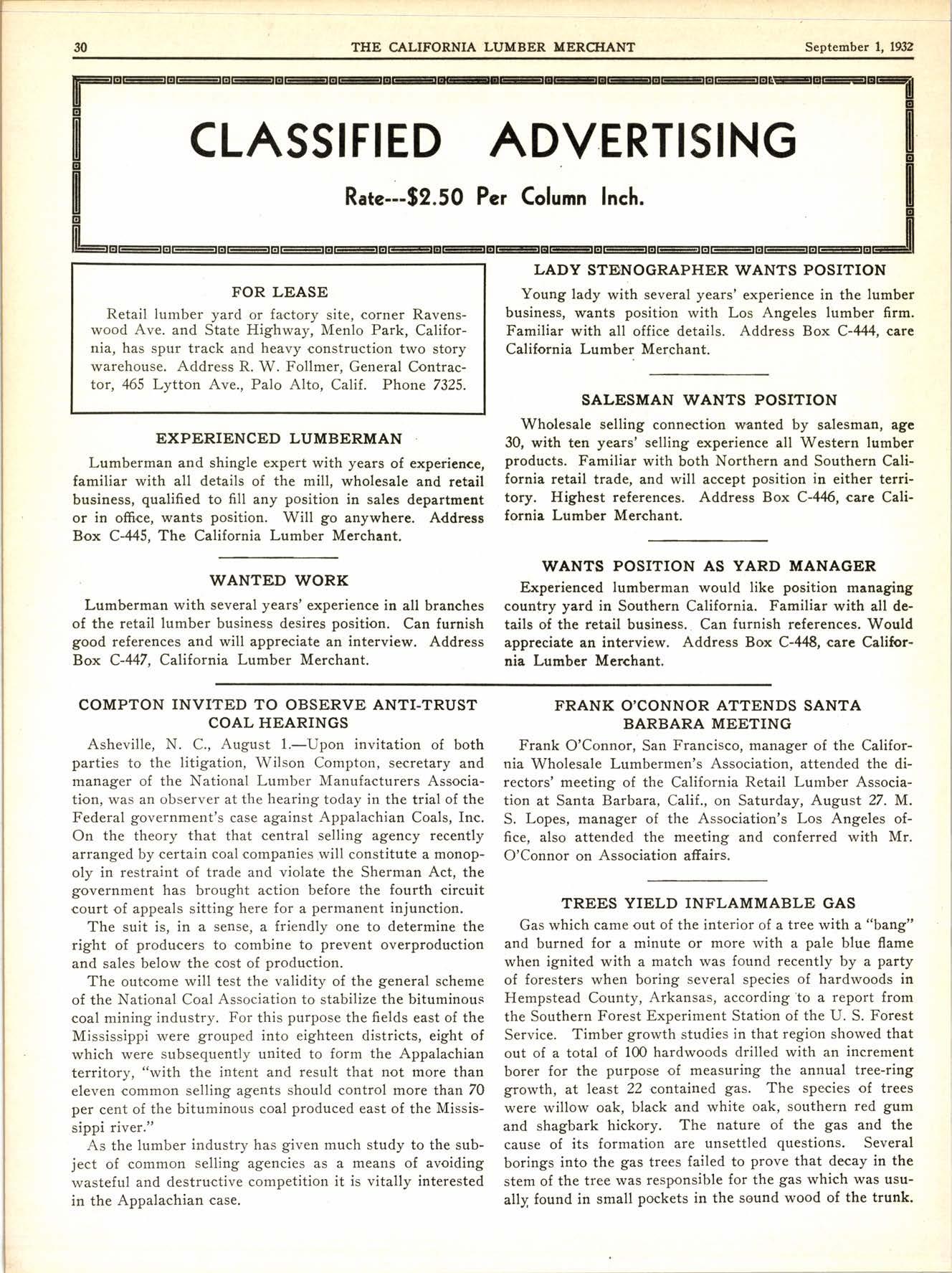
3 minute read
Western Pine Association Adopts Program Recommended bv Economics Committee
: At the semi-annual meeting of the Western Pine Association held at the Portland Hotel, Portland, Oregon, on .Thu/sday, August ll; the program recommended by the ;Economics Committee w1gra.dopted. The varioui sections qf the program were outlinia. "na discussed by Maj. David T. Mason, ?nanager of,the,Association. The treasurer's re4iort was made by C. L- .Isted. President B. W. Lakin bresided at the meeting.
Wilron Compton, Natiohal Lumber Manufacturers As- 'stociation; W. Bi Greeley, West Coast Lumbermen's Association; F. H. Morrill, Assistant Forrester, U. S. Forest '$ervice; John C. Merriam, National Timber Conservation Board, and W. C. Ruegnitz, Four.L Organization, also addressed the meeting
, In presenting the report of the Economics Committee, j. P. Weyerhaeuser, chairman, said:
, , "In the world at large we appear to be in a period of tiansition from the older order of things of the days before the war, to something new, we do not know just what. We see in Europe the experiments of fascism in Italy, com,munism in Rugsia,,the dole in England, and a more chaotic situation in some other countries. We see disorder in the Orient; in those courrtries with enormous masses of population, China and India. There is unrest in South American countries. Australia has gotten into financial difficulties through its social experiments. In our own country, also, we have a "noble experiment", which does not seem to be Working out well; but here there are problems of much greater importance than prohibition, such as employment and taxation. We are ip a pgriod of transition. To what kind of new epoch it is leading we cannot be sure, but we may be reasonably sure that it will not be an improvement tipon former conditions if we merely fuinble. 'We can p,robably crpate an improved general situation if we can firrget narrow individualism, stop drifting, use' our brains f6r thorough planning and cooperate in carrying out sou.r.r{ plans.
,i "h the lumber induqtry. "plpp.wq are. going through a ,period of ,'terrific stormtatd'sttess. Ifere also we are passihg into a new epoch. The.belief in.an.approachirtg timber bfrortage, whlch sustained'ind enhaiiced timber values for !o mqny years, is about dernolished. We mu,St put ilew and safe foundations under our ihausiry. Many have been etudying the affairs of our industry, and have been makingfecommendations. The most notable study and set of rec<immendations for our industry yet made is that of the Timber Conservatign Board.
. "With these general recommendations before us, it has deemed desirable, from the point of view of the western pine lndustry, to study the situation thoroughly; to reach agreelnent as to which are our really vital problems; to agree upon sound solutions for those problems and especially to select or devise machinery for applying efiectively the solutions to the problems.
"fn the past it has seemed that we have had too strong a tendency toconsider first this suggestion, and then that one,. to half forget some valuable recommendations while temporarily attending to others. Apparently we have failed to map out the job as a whole and to develop and agree upon a program covering all important needs-a fully balanced program. It is the purpose of the Economics Committee to present a program giving a birds-eye-view showing practi,cally at a glance (1) the vital problems, (2) the sound '.solutions, and (3) the machinery showing r,vhat we have to do and how to do it.
"Our committee in working rvith these problems had a feeling that in the past it has too often been the tendency to seek a solution for a given problem, and then in efiect to assume that the solution once found would apply itself, and the problem would be solved. Now we realize that a solution to any problem is of no use whatever unless we make sure that we have the right machitrery, with sufficient power to put the solution into efiect, and then see to it that the machinery acually works. In our Western Pine Association, and in similar associations in the industry, we already have this machinery, which constitutes such government as the industry has. We need a more effective, stronger government, and for the purpose we must strengthen our trade associations. In addition, it is clearly essential that there be strong cooperation between various economic groups, such as the lumber industry, banking, railroads, farming, mining, etc. For this inter-economic g'roup cooperation there must be built up effective machinery.
"T[e Economics Committee recommends for your adoption this broad program for our industry. This program is by ng.mehqs a-final finished job. We believe that it does set up as it is a sound frame work into which the essential detail rnay',be built, The more important of this detail 'we have indicg!!4:.,Tle program to be effective $,rust be p.living ,'thing,.to'be.,improved and adjusted to meet circumstances as w.g,gg,?lo"ng. It must be revised and adjusted tq permit effcctive'cooperation with other groups.
. ' "The committeem_en !p. approaching thiS work have tried 'to forget ti\eir individual interests and formulate a program w\!ch recognizes the interests of (1) the owners, (2) the 'employees, (3) the management of our industry, and finally, (4) the pubiic. We qsk that you also take this point of view."
The program adopted follows:
(Continued on Page 26)
ITalker & Eisen, architects, used moulded casing-trim for the corridor door openings of the Beverly - ITilshire ApartmentHotel at Los Angeles. The typical unit here illustrated is of Philippine, stained dark red.
Fluted pilaster casings and ornamental cap-trim form a delightful frame for this interior doorway in a private residence at Santa Monica. Jambs, trim and door are Sugar Pine, enameled finish. William E. Flannery, architectl Julia Morgan, associate.











